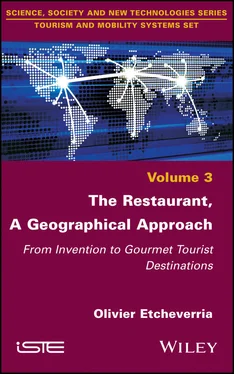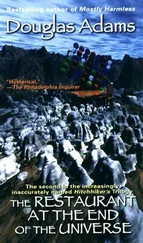111 River Street
Hoboken, NJ 07030
USA
www.wiley.com
© ISTE Ltd 2020
The rights of Olivier Etcheverria to be identified as the author of this work have been asserted by him in accordance with the Copyright, Designs and Patents Act 1988.
Library of Congress Control Number: 2020930311
British Library Cataloguing-in-Publication Data
A CIP record for this book is available from the British Library
ISBN 978-1-78630-434-6
The impact of a restaurant’s location on its environment is rarely studied, yet it can be a major factor.
We can even talk about a total synergy, and there are many examples: what would the city of Roanne (and even its station!) be without the Troisgros brothers? What would the city of Saulieu be without Bernard Loiseau’s Côte-d’Or , Valence without the Pic , Laguiole without the Bras , Saint-Bonnet-le-Froid without the Marcon , Fontjoncouse without Gilles Goujon, etc.?
Lost and unknown places are at the top of the bill thanks to the grace of a restaurateur who attracts amateurs, tourists, the curious among us, etc.
The wine-growing regions have understood this impact of gastronomy on their territory and are developing wine tourism at a fast pace and with great success. Because, in fact, what is France’s DNA, if not the combination of food, wine and landscapes?
I am delighted that a book is now devoted to this subject. I thank Olivier Etcheverria and I wish all readers a pleasant read!
Guy SAVOY
Chef
Restaurant Guy Savoy
11, quai de Conti, Paris
“If worst comes to worst, as long as bistronomy cultivated its garden in its favorite neighborhoods, it would do no harm. Going somewhere else is another story. Tackling the 8th arrondissement in this case is not an easy task. It is undoubtedly the most difficult area in Paris, the most paradoxical. Both poor in gastronomic culture, but of a hysterical demand; wealthy, incidentally expensive, but regularly stingy; lily-livered or exhausted, there is enough to unscrew the head, swallow the chef’s hat. Cooking in this district requires nerves of steel, a strong chest, the willpower of a sumo. That’s why the arrival of Nicolas Chimot and Manon Fleury (previously Astrance and Semilla respectively) was a bit scary. Like a true thermal, cultural, a limit rake. To welcome this duo, you probably needed the skin of a good old crocodile ( Le Mermoz ), a true Parisian bar counter, with its elbow bar, its mosaics and the sound reverberations of a hyper-eighth audience: loud in mouth, in ringtones – and me as well. It is to be hoped that such neat plates will nail down the local mouths. For on this side, the partition is boiling, piercing. It does not depict a tapestry, nor is it stuck-up. It removes its coat, rolls up its sleeves and enters the arena. It’s funny, as there’s so much urgency to demonstrate, like these cockles and beans in fresh mint bouillon. And especially this striking dish of spinach, apparently harmless and predictable, hitting hard with a green wheat and a stunning cream of cumin. The rest is carefully bistroed: roasted white asparagus, curdled milk, blood orange, new turnip perch chicken, vinegar apple, Saint-Gilles whiting, crayons-sabayon leeks with herb butter. Desserts languishing in a benevolent horizontality: candied rhubarb-syrup of hibiscus-streusel or panacotta-pink grapefruit-ananis from Iran. The dish of the month.” [SIMO 18, author’s translation]
This review by François Simon from the restaurant Le Mermoz , 16, rue Jean-Mermoz, in the 8th arrondissement of Paris, is a delicious demonstration of the fact that the restaurant is a geographical object. It raises the stakes of the logic and strategies of its location and the relationships maintained with its location space. The enunciation of the dishes reveals choices of supply and highlights the interplay of discourses and gastronomic imaginations that symbolically positions the restaurant between integration and travel.
The restaurant was born in the city, and, more precisely, in the center of the city. It is indeed found in a context of fullness, in the spatial context of density and diversity. The geographical location and distribution of restaurants should be seen in relation to the differential qualities of urban areas, growth dynamics, and urban planning and development. The restaurant derives a large number of its characteristics from those of the urban environment. Its organization, functioning and development require proximity and accessibility that result in concentrations.
Correlatively, restaurants qualify, distinguish and participate in the prioritization of cities. They play a role in the relative geographical positioning of a city and its place in city networks. Restaurants are mainly frequented by urban eaters; these being both permanent and temporary residents, e.g. tourists. Restaurant attendance is an urban practice that has a particular impact on the city or places with urban qualities. As a result, restaurants demonstrate effects on the city, its structure and dynamics. They supply the city’s urban properties. They play a role in its influence and attractiveness.
Restaurants play an important role in shaping the tourist image and building a city’s tourist reputation. Tourists deploy their recreational tourism practices in a privileged way. They play a role in the development of tourism in the area and in the emergence of forms of food tourism. They are sometimes gourmet tourist destinations. The restaurant’s role in creating the conditions necessary for local development is real. Chefs have an effect on places and in the creation of new ones, in both urban and rural areas. This influence on places leads to the question of the characterization of the restaurant as a form of heritage.
Thus, the study of the establishment, operation and development of restaurants mobilizes geographical themes: spatial location, distribution and diffusion logics; dynamics of globalization, tourism and heritage; processes of identity construction and even territorial symbolization; enhancement and re-enhancement of city–countryside relations; emergence and re-emergence of the question of nature in the city. The salience, originality, notoriety and vitality of restaurants play a role in the organization and dynamics of spaces. Symmetrically, the qualities of spaces and customers influence the characteristics of restaurants, the cuisine served, the service, the decor, the management style, the discourses and the gastronomic imagination that infuse and diffuse there.
There is also a questioning and re-questioning of the place of customers in the location and functioning of restaurants and their geographical role. The restaurant only exists if it is frequented by customers, if there are gourmet practices of permanent and temporary inhabitants. The choice and attendance of a restaurant are linked to the qualities of the location space. Hence, a geographical approach to restaurants differs from a geography of restaurants. It makes the customer the joint inventor and central actor of the restaurant by trying to analyze the practices, their sensitive relationship, their preferences, their discourses and the gastronomic imagination of the restaurant. Indeed, restaurant practices depend on the most pleasant geographical ambiences and landscape amenities to develop them, from which the desire to eat and drink is born. There is no gourmet predisposition of a particular place to host a particular restaurant and the choices and practices of the customer determine the location of a particular restaurant in a particular place.
This book does not deal with “great” restaurants. However, the study of locations, the relationship between restaurants and their locations, and their geographical effects lead to highlighting the exemplary nature of “great” restaurants. It should be recalled that for the Michelin Guide , the attribution of stars resonates with geographical logic: 1-star restaurant: a very good restaurant – worth the stop; 2-star restaurant: excellent cooking that is worth a detour! – and a 3-star restaurant: exceptional cuisine that is worth a special journey!
Читать дальше












